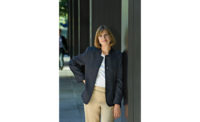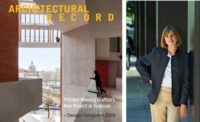April 2020 Editorial: The Pandemic Is Changing How We Practice and How We Live

Cathleen McGuigan, editor-in-chief of Architectural Record. Photo © Jenna-Beth Lyde
In April, our thoughts here at the magazine typically turn to residential design, because this is the month we publish our annual issue of Record Houses.
But this April, our feelings about the house are radically changing. The home is no longer just an abode that reflects our tastes or the canvas on which an architect has played out new design ideas. Instead, each of our own houses is becoming an essential redoubt, a refuge to shelter in place as America and the world tries to ride out the coronavirus crisis. As we go to press, workplaces are closing; trips are canceled; museums and restaurants are shuttered. If we like the design of our houses, that’s good, because we’re going to spend more time at home than we ever imagined.
Architecture firms, like other businesses, have had to adjust quickly to the new normal. Every day, more architects notify us that their offices are temporarily going dark. Big practices, with far-flung projects, have been communicating via advanced technology for some time, and so have moved with relative ease from staff working collaboratively in offices to working from home. Gensler, with 50 offices worldwide and over 6,000 employees, had weeks of experience with the coronavirus shutdown in China and other parts of Asia before closing all its offices in North America, Europe, and Latin America, with staff now working and telecommunicating remotely. One thing the firm leadership also learned from their colleagues in China, a spokeswoman noted, was to “ensure people are still . . . maintaining a healthy balance with time away from doing work.” Similarly, KPF had gained experience from the firm’s Hong Kong and Shanghai outposts, before moving everyone in its New York headquarters home. “We’ve asked our staff to be disciplined, to keep journal-like logs,” said KPF President James von Klemperer, “but also to exercise, take breaks, and eat well.”
For smaller firms, the shifts away from collaborating in the office—if that is what they have decided to do—have been more difficult, with leaner staffs and fewer digital tools. In San Francisco, some offices first decided on “optional” attendance if an employee could walk or bike to work, but the sudden mandatory order last month to close businesses and shelter in place meant firms were scrambling to finish setting up equipment and protocols. “It’s been an exhausting few days,” wrote Eric Robinson, principal at the 23-person Paulett Taggart Architects, a firm known for designing affordable housing. The last in-office staff meeting, with “many young ones who’ve never even seen a recession, was emotional,” he said. “We’re trying to communicate a level of calm to our staff. It’s not easy.”
Architecture schools, as the pandemic surged, have had to make dramatic changes as well. Many programs will complete the term remotely. Deans, such as Sarah Whiting of Harvard’s Graduate School of Design (GSD), have been informally discussing best practices with each other. “It’s a huge challenge,” she said. One GSD professor became a pioneer of remote teaching early in the term, after she had to self-isolate following a trip to South Korea. “Zoom was much more convenient and powerful than I expected,” said Jungyoon Kim, who teaches landscape design, of the software program that lets you draw remotely on another’s laptop. “In Zoom crits, ‘Can I share my screen and stop yours?’ means, ‘Can I have trace paper?’” Still, she has deeply missed the nuanced personal interaction with her students. “Any virtual relationship should still be based on real affection and interest,” she says.
Jeanne Gang has brought her firm’s experience with advanced digital tools to the GSD studio she is teaching and believes her students are transitioning easily to remote learning—“without a hitch so far.” Lacking access to the GSD fabrication lab, they are being encouraged to make “analog models at home” or find “other inventive forms of making.” While she believes the remote studio will make her students “stronger at communicating their ideas,” she also knows what’s missing. As students and practitioners become ever more fluent in new technologies, what they lose, ironically, is something her own office, now working remotely, has always prized. “We value our community culture and our shared social space so much,” she says, “which makes being apart more challenging.”
Perhaps as a relief from these dark days, you might find in this issue inspiring or intriguing ideas of home—such as Thomas Ryan’s Three Chimney House in Virginia’s horse country (page 74) or a retreat in the high desert of California by Aidlin Darling (page 94). Or, for a particularly daring marriage of design and nature, check out Ryue Nishizawa’s Ochoquebradas House (page 62), perched on a coastal cliff in Chile. Looking at the images, you can almost hear the waves crashing on the rocks below, as the endless tide rolls in and out.



